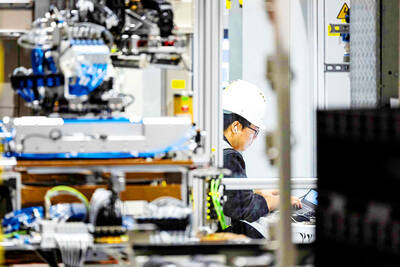Epistar Corp (晶元光電), the nation’s biggest LED chipmaker, yesterday said it would raise its holdings in Huga Optotech Inc (廣鎵光電) to 100 percent from the existing 48 percent via a share swap worth NT$3.47 billion (US$116 million).
The consolidation came as oversupply and sluggish demand brought most LED companies into the red in the first quarter and their outlook was dim amid persistent economic uncertainty in Europe.
The acquisition aimed to enhance the company’s efficiency and boost its competitiveness, Epistar said in a statement filed to the Taiwan Stock Exchange.
Epistar shareholders would obtain 4.85 Huga shares for each of Epistar common share, according to the statement. This offering means that Epistar will pay NT$12.68 per Huga share, a 1.44 percent premium, compared with Huga’s closing price of NT$12.5 yesterday.
Epistar will issue 56.45 million new common shares, totaling NT$3.47 billion, to Huga shareholders based on Epistar’s closing price of NT$61.5 yesterday.
The transaction is expected to be closed on Dec. 28.
Huga would become a fully-owned LED chip unit of Epistar and after that the company will be delisted from the local stock market.
Epistar said the deal would have a positive impact on the company’s profits and net value, because the company’s scale would expand and costs would be reduced.
The company will operate about 300 units of MOVCD machines after the transaction, making it the world’s No. 2 LED chipmaker.
Epistar lost NT$515 million in the first quarter, while Huga lost NT$57 million after booking NT$1.14 billion in losses for last year.

CHIP RACE: Three years of overbroad export controls drove foreign competitors to pursue their own AI chips, and ‘cost US taxpayers billions of dollars,’ Nvidia said China has figured out the US strategy for allowing it to buy Nvidia Corp’s H200s and is rejecting the artificial intelligence (AI) chip in favor of domestically developed semiconductors, White House AI adviser David Sacks said, citing news reports. US President Donald Trump on Monday said that he would allow shipments of Nvidia’s H200 chips to China, part of an administration effort backed by Sacks to challenge Chinese tech champions such as Huawei Technologies Co (華為) by bringing US competition to their home market. On Friday, Sacks signaled that he was uncertain about whether that approach would work. “They’re rejecting our chips,” Sacks

It is challenging to build infrastructure in much of Europe. Constrained budgets and polarized politics tend to undermine long-term projects, forcing officials to react to emergencies rather than plan for the future. Not in Austria. Today, the country is to officially open its Koralmbahn tunnel, the 5.9 billion euro (US$6.9 billion) centerpiece of a groundbreaking new railway that will eventually run from Poland’s Baltic coast to the Adriatic Sea, transforming travel within Austria and positioning the Alpine nation at the forefront of logistics in Europe. “It is Austria’s biggest socio-economic experiment in over a century,” said Eric Kirschner, an economist at Graz-based Joanneum

BUBBLE? Only a handful of companies are seeing rapid revenue growth and higher valuations, and it is not enough to call the AI trend a transformation, an analyst said Artificial intelligence (AI) is entering a more challenging phase next year as companies move beyond experimentation and begin demanding clear financial returns from a technology that has delivered big gains to only a small group of early adopters, PricewaterhouseCoopers (PwC) Taiwan said yesterday. Most organizations have been able to justify AI investments through cost recovery or modest efficiency gains, but few have achieved meaningful revenue growth or long-term competitive advantage, the consultancy said in its 2026 AI Business Predictions report. This growing performance gap is forcing executives to reconsider how AI is deployed across their organizations, it said. “Many companies

France is developing domestic production of electric vehicle (EV) batteries with an eye on industrial independence, but Asian experts are proving key in launching operations. In the Verkor factory outside the northern city of Dunkirk, which was inaugurated on Thursday, foreign specialists, notably from South Korea and Malaysia, are training the local staff. Verkor is the third battery gigafactory to open in northern France in a region that has become known as “Battery Valley.” At the Automotive Energy Supply Corp (AESC) factory near the city of Douai, where production has been under way for several months, Chinese engineers and technicians supervise French recruits. “They